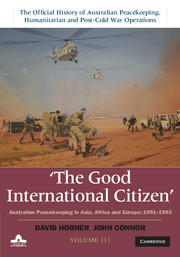Book contents
- Frontmatter
- Contents
- Maps
- Preface
- Chronology 1989–99
- Abbreviations
- Part 1 Strategy and policy
- Part 2 Cambodia
- 3 From Angkor Wat to Pol Pot
- 4 Law and order on the border
- 5 An Australian peace proposal
- 6 First into Phnom Penh
- 7 The roadblock
- 8 Change in plan
- 9 ‘Democracy's surprise triumph’
- 10 Developing Operation Banner
- 11 Winding up Operation Banner
- Part 3 Western Sahara
- Part 4 Former Yugoslavia
- Part 5 Watch on Iraq
- Appendix A United Nations Security Council resolutions
- Appendix B Major office bearers, 1991–99
- Bibliography
- Index
- Plate section
- References
9 - ‘Democracy's surprise triumph’
Australians in the UN Transitional Authority in Cambodia, 1993
from Part 2 - Cambodia
Published online by Cambridge University Press: 12 May 2022
- Frontmatter
- Contents
- Maps
- Preface
- Chronology 1989–99
- Abbreviations
- Part 1 Strategy and policy
- Part 2 Cambodia
- 3 From Angkor Wat to Pol Pot
- 4 Law and order on the border
- 5 An Australian peace proposal
- 6 First into Phnom Penh
- 7 The roadblock
- 8 Change in plan
- 9 ‘Democracy's surprise triumph’
- 10 Developing Operation Banner
- 11 Winding up Operation Banner
- Part 3 Western Sahara
- Part 4 Former Yugoslavia
- Part 5 Watch on Iraq
- Appendix A United Nations Security Council resolutions
- Appendix B Major office bearers, 1991–99
- Bibliography
- Index
- Plate section
- References
Summary
On 4 May 1993 white-robed Buddhist nuns, orange-robed monks and lay men and women set off from the temples of Angkor Wat on a ‘Walk for Peace’ that would arrive in Phnom Penh on 22 May, the day before voting commenced for the national election. Peace was an element that appeared to be in short supply in Cambodia in the days leading up to the poll. On 3 May, the day before the walkers left Angkor Wat, the State of Cambodia (SOC) garrison in the nearby town of Siem Reap had been attacked by the Khmer Rouge, and two civilians had died in the crossfire. But, as the walk passed through Kompong Thom, the Cambodian province that had seen the most violence, villagers travelled long distances to line the road, greet the 380 pilgrims and offer them food, water and shelter for the night. Four thousand people welcomed the walkers into the city of Kompong Thom on 11 May. Despite the mayhem around them, the protection of the local population meant that the monks, nuns and their companions had made the journey across the province unharmed. Throughout Cambodian history, the powerful few had used violence to control the people. Many believed that the election could conform to this pattern. The Cambodian people's support for the ‘Walk for Peace’, however, revealed a refusal to be intimidated by the men of violence. More than four million Cambodians would cast their votes in the election and make clear their determination to end the decades of war and violence that had wracked their nation.
- Type
- Chapter
- Information
- The Good International CitizenAustralian Peacekeeping in Asia, Africa and Europe 1991–1993, pp. 193 - 224Publisher: Cambridge University PressPrint publication year: 2014

